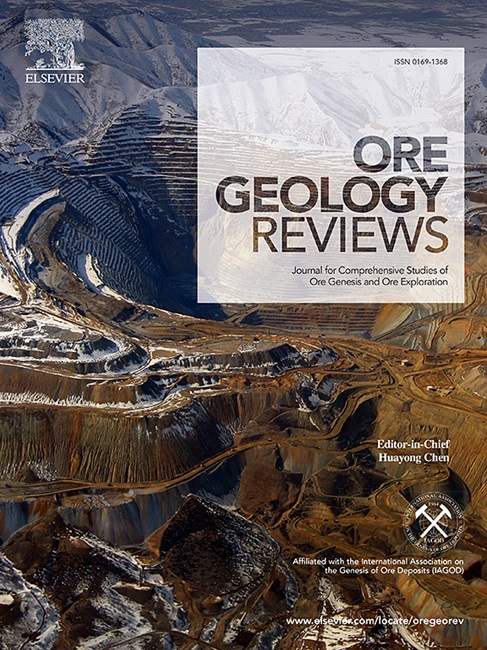Comparison of gold precipitation processes between disseminated and quartz vein ores of orogenic gold deposits: insights from the Linglong gold field, Jiaodong Peninsula, China
IF 3.6
2区 地球科学
Q1 GEOLOGY
引用次数: 0
Abstract
The presence of disseminated ores and quartz vein ores in orogenic gold deposits, has given rise to an ongoing discourse surrounding the mechanisms of gold precipitation. This study employs trace element analysis and sulfur isotope analysis of pyrite in the orogenic Linglong gold field to comparatively assess the gold precipitation processes. Pyrite in disseminated ores (Pyd) is classified into Pyd1 and Pyd2, with gold primarily hosted in Pyd2, followed by Pyd1. In the context of quartz vein ores (Pyv), pyrite is subdivided into Pyv1, Pyv2, and Pyv3, with gold predominantly hosted in Pyv3. In the context of disseminated ores, the Au and As content is below the solid solubility limit of Au in pyrite, thereby suggesting that gold primarily exists as a solid solution (Au1+). The lg (Co)/lg (Ni) ratios in Pyd are −0.11 ± 1.23, predominantly below 1, suggesting water–rock interactions. The significantly lower ratios observed in Pyd2 (−0.26 ± 1.21) suggest intense water–rock interaction. The Ag/Co ratios in Pyd1 and Pyd2 are 0.074 and 23.65, with relative standard deviations (RSD) of 31.57 and 25.91, respectively, indicating weak fluid boiling. Furthermore, the sulfur isotope values (medians of 5.51 ‰ ± 0.81 ‰) indicate stable oxygen fugacity in disseminated ores. The presence of visible gold in the quartz veins ores of Pyv2 and Pyv3, in contrast to the low gold content observed in the pyrite (median value of 0.03 ppm), further substantiates these observations. The lg (Co)/lg (Ni) ratio for Pyv is 0.98 ± 2.04, which is close to 1, indicating weak water–rock reactions. The Ag/Co ratios in Pyv1, Pyv2, and Pyv3 are 0.0008, 0.009, and 0.09, with RSD values of 10.5, 63.55, and 89.86, respectively. The values of Pyv2 and Pyv3 are significantly higher than those in Pyv, indicating fluid boiling. Furthermore, a decline in sulfur isotope values from 7.6 ‰ ± 0.2 ‰ in Pyv1 to 5.0 ‰ ± 1.2 ‰ in Pyv3 is indicative of an increase in oxygen fugacity. The analysis of pyrite indicates that gold precipitation in disseminated ore is predominantly attributable to water–rock reactions. In contrast, precipitation in quartz vein ores is primarily driven by fluid boiling, which is concomitant with elevated oxygen fugacity.

造山带浸染型金矿与石英脉型金矿的金沉淀过程比较——来自胶东玲珑金矿的启示
造山带金矿床中浸染状矿石和石英脉状矿石的存在,引起了围绕金沉淀机制的持续讨论。本研究采用造山带玲珑金矿区黄铁矿微量元素分析和硫同位素分析对比评价金的沉淀过程。浸染状矿石中黄铁矿(Pyd)分为Pyd1和Pyd2,金主要赋存于Pyd2,其次为Pyd1。在石英脉矿石(Pyv)中,黄铁矿分为Pyv1、Pyv2和Pyv3,金主要赋存于Pyv3中。浸染型矿石中Au、As含量均低于Au在黄铁矿中的固溶极限,表明金主要以固溶体(Au1+)形式存在。Pyd的lg (Co)/lg (Ni)比值为- 0.11±1.23,主要小于1,表明水岩相互作用。Pyd2中较低的比值(- 0.26±1.21)表明强烈的水岩相互作用。Pyd1和Pyd2的Ag/Co比值分别为0.074和23.65,相对标准偏差(RSD)分别为31.57和25.91,表明流体沸腾程度较弱。硫同位素值(中位数为5.51‰±0.81‰)表明浸染状矿石具有稳定的氧逸度。Pyv2和Pyv3石英脉矿石中可见金的存在,与黄铁矿中观察到的低含金量(中位数为0.03 ppm)形成对比,进一步证实了这些观察结果。Pyv的lg (Co)/lg (Ni)比值为0.98±2.04,接近于1,表明水岩反应较弱。Pyv1、Pyv2和Pyv3的Ag/Co比值分别为0.0008、0.009和0.09,RSD值分别为10.5、63.55和89.86。Pyv2和Pyv3值明显高于Pyv值,说明流体沸腾。此外,Pyv1的硫同位素值从7.6‰±0.2‰下降到Pyv3的5.0‰±1.2‰,表明氧逸度增加。黄铁矿分析表明,浸染状矿石中金的析出主要是水岩反应。石英脉矿石中的沉淀主要由流体沸腾驱动,并伴有氧逸度升高。
本文章由计算机程序翻译,如有差异,请以英文原文为准。
求助全文
约1分钟内获得全文
求助全文
来源期刊

Ore Geology Reviews
地学-地质学
CiteScore
6.50
自引率
27.30%
发文量
546
审稿时长
22.9 weeks
期刊介绍:
Ore Geology Reviews aims to familiarize all earth scientists with recent advances in a number of interconnected disciplines related to the study of, and search for, ore deposits. The reviews range from brief to longer contributions, but the journal preferentially publishes manuscripts that fill the niche between the commonly shorter journal articles and the comprehensive book coverages, and thus has a special appeal to many authors and readers.
 求助内容:
求助内容: 应助结果提醒方式:
应助结果提醒方式:


